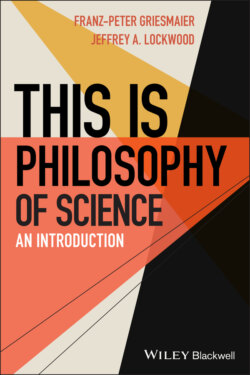Читать книгу This is Philosophy of Science - Franz-Peter Griesmaier - Страница 26
2.2.2 Causes and Evidence
ОглавлениеThe main issue with the view that the ultimate evidence consists in features within a person’s sensory field is that it seems highly unnatural. Clearly, I don’t seem to observe edges and colors and only then form, by some unknown process, beliefs about my environment. I don’t seem to first see rectangularly shaped red patches supported by a shiny, gray surface and then infer that there are books with red covers in my old metal bookcase. I seem to see the books and the bookcase themselves, directly, as it were. If someone were to ask me why I believe that my books are still in my bookcase, I would certainly say something like, “Because I can see them,” rather than, “Because this particular distribution of red rectangles on a shiny gray surface is good evidence for the presence of my books in the bookcase.” And yet, it is of course correct to say that seeing the red rectangles on a gray surface is involved in my belief that the books are still there.
In order to resolve this tension, we need to make a distinction between a description of the processes by which we become aware of our environment and the question as to what counts as evidence for what. Cognitive science tells us that our beliefs about the world stem from stimulations of various sense organs, which are then processed by our brain and result eventually in beliefs about what’s out there. However, this process from sensory stimulations to beliefs is not obviously the same as the grounding of our beliefs on evidence. Reflecting the ordinary ways in which we talk about evidence, we will adhere for our purposes to a distinction between causal and evidential relations. The path from sensory stimulations to beliefs about the world consists in a long chain of causal links. To correctly describe and understand this causal chain is the task of cognitive science. The task of the philosophy of science is to isolate those elements in the causal chain that stand in an evidential relation to the relevant beliefs.
What is the evidential relation? For our purposes, it may be enough to say that some observation counts as evidence for a person’s belief if the observation provides the person with a good reason for her belief. Seeing books in my book case provides me with a good reason for believing that my books are there. Ordinarily, I do not even become aware that the observation of my books is based on particular sensory stimulations. Thus, those sensory stimulations, in virtue of going on outside of my awareness or unconsciously, do not provide me with good reasons for believing my books are still in their bookcase. The sensory stimulations are the ultimate cause of my seeing and hence my belief, but since they do not provide me with a good reason to have the belief, they do not count as my evidence.
Of course, what counts as a good reason for a person to believe something depends partly on factors involving that person, most importantly perhaps their background knowledge. Recall the aliens from earlier. Not having any knowledge about humans and their diseases in the background, the evidence in the form of Koplik spots is not available to them. Just as we argued that if I am unaware of my sensory stimulations, they can’t be reasons for me, if the aliens don’t know what Koplik spots are and what they indicate, the spots do not provide good reasons for them to believe that the person in front of them is about to come down with the measles. But we don’t have to invoke aliens. Any nonexpert looking at Koplik spots will fail to receive evidence for the measles.
Thus, whether or not an observation is evidence for a person depends crucially on what the person is bringing to the table in terms of background knowledge. The physician sees the Koplik spots as Koplik spots and thereby gains evidence for her belief that the patient is coming down with the measles. I, a nonexpert, see the same spots, but I do not see them as Koplik spots. Thus, they are not evidence for me, because they don’t provide me with good reasons for believing that I am confronted with a case of the measles. Only observations that are seen as this or that can be evidence for (or against) some hypothesis.
Another way of putting the same point is this: During the processing of sensory stimuli, we bring – often automatically – various categories, background knowledge, and similar things, to bear. Thus, categorized observations are what constitutes evidence. This fact has been identified as the theory-ladenness of observation and/or measurement, which we discuss below and in later chapters.
Some readers might worry that we are overintellectualizing evidence, seemingly requiring that evidence is always conceptualized (e.g., seeing a discoloration as a Koplik spot). Such readers are in good company – there are a number of prominent epistemologists who believe that nonconceptualized experiences can be good reasons for having certain beliefs. For example, simply tasting something salty is a good reason for believing it to be salty, even if we don’t have the concepts to properly express our belief (that’s why we often say that something tastes like chicken if we lack the appropriate concepts). However, it seems to us that in the empirical sciences, unconceptualized experiences hardly ever play a role as evidence, and so we leave them aside.
